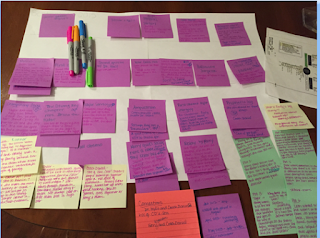On Tuesdays, the writing community at Two Writing Teachers hosts the Slice of Life. Everyone is welcome to join in by writing, commenting, or just reading slices from around the world!
If you don't already use the Teacher's College Writing Checklists with pictures that can be found in the most recent version of Writing Pathways by Lucy Calkins, I highly recommend them.
These checklists break the skills and expectations of the Common Core into discrete skills across all three genres of writing. The checklists use student-friendly language and pictures that make the expectations clear and attainable to students.
These checklists break the skills and expectations of the Common Core into discrete skills across all three genres of writing. The checklists use student-friendly language and pictures that make the expectations clear and attainable to students.
I have used these checklists in many different ways in my work with teachers and with students. I have made them into checklists, I have seen teachers enlarge them into anchor charts, I have given them to students as tools for independence and repertoire, I have used them to differentiate the curriculum for students who struggle, as well as for students who exceed expectations... Yesterday, I used them in a fourth-grade classroom for an inquiry lesson. Except for two students who are new to the district, all of the students in the classroom were familiar with the checklists from using them in third grade--how great is that?!?! So, I handed out the fourth grade checklists for narrative writing, put the third-grade checklists on the overhead projector, and challenged the students to work in groups to figure out the different expectations we'd have of their writing and the different goals they should set. The students used highlighters and sticky notes.
Then, together we created a chart of the increasing expectations.
I was sure to write down the contributing groups on the chart. That way students have more ownership of the informations that's on the chart. Also, (and they may not realize it yet) they have more accountability for what's on that paper!
All in all, the students did a fantastic job in about twelve minutes of recognizing that in fourth grade, a lot more is expected of them in terms of development and elaboration when it comes to narrative writing. They are excited to try out some drafts, incorporating the higher expectations of fourth grade. This is an activity that would work with any grade and any genre, as long as you have similar checklists and a continuum of writing skills.
Happy Writing!
Then, together we created a chart of the increasing expectations.
I was sure to write down the contributing groups on the chart. That way students have more ownership of the informations that's on the chart. Also, (and they may not realize it yet) they have more accountability for what's on that paper!
All in all, the students did a fantastic job in about twelve minutes of recognizing that in fourth grade, a lot more is expected of them in terms of development and elaboration when it comes to narrative writing. They are excited to try out some drafts, incorporating the higher expectations of fourth grade. This is an activity that would work with any grade and any genre, as long as you have similar checklists and a continuum of writing skills.
Happy Writing!

















